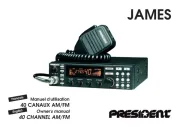Model Frequency range Max. output power
NX-5700-E
TX/RX 136.000 - 174.000 MHz 25 W
GPS 1575.42 ± 1 MHz –
Bluetooth 2402 - 2480 MHz Class2 / 2.5 mW
NX-5800-E
TX/RX 400.000 - 470.000 MHz 25 W
GPS 1575.42 ± 1 MHz –
Bluetooth 2402 - 2480 MHz Class2 / 2.5 mW
NX-3720-E TX/RX 136.000 - 174.000 MHz 25 W
NX-3720G-E
TX/RX 136.000 - 174.000 MHz 25 W
GPS 1575.42 ± 1 MHz –
Bluetooth 2402 - 2480 MHz Class2 / 2.5 mW
NX-3820-E TX/RX 400.000 - 470.000 MHz 25 W
NX-3820G-E
TX/RX 400.000 - 470.000 MHz 25 W
GPS 1575.42 ± 1 MHz –
Bluetooth 2402 - 2480 MHz Class2 / 2.5 mW
TK-D740-E TX/RX 136.000 - 174.000 MHz 25 W
TK-D840-E TX/RX 400.000 - 470.000 MHz 25 W
DIGITAL TRANSCEIVER
USER GUIDE
This User guide covers only the basic operations of
your radio. For using details instruction manual, refer
to the following URL or QR code.
https://manual.kenwood.com/files/B5K-0647-00.pdf
SUPPLIED ACCESSORIES
Carefully unpack the transceiver. We recommend that you identify the items listed
in the following list before discarding the packing material. If any items are missing
or have been damaged during shipment, fi le a claim with the carrier immediately.
Item NX-5000 series NX-3000 series
TK-D740
TK-D840
DC power cable with fuses (15 A) 1 1
Mounting bracket 1 1
Microphone 1 –
Microphone hanger 1 –
4 x 16 mm self-tapping screw 3 –
Screw set
5 x 16 mm self-tapping screw 4 4
M4 x 6 mm hex-headed screw with washer 4 4
Spring washer 4 4
Flat washer 4 4
User guide 1 1
BASIC OPERATION
Display
Illumination sensor
Status indicator Speaker
SpeakerStatus indicator
NX-3000 series
NX-5000 series
Display
TK-D740/ TK-D840
Display
TX/RX indicator
Status indicator
Operation buttons
Operation buttons
Operation buttons
Microphone
PTT switch
Speaker
SWITCHING POWER ON/OFF
Press to switch the transceiver ON.[ ]
Press [ ] again to switch the transceiver OFF.
ADJUSTING THE VOLUME
Press the button programmed as [Volume Up] to increase the volume.
Press the button programmed as [Volume Down] to decrease the volume.
SELECTING A ZONE AND CHANNEL
Select the desired zone and channel using the buttons programmed as / [Zone Up]
[Zone Down] [Channel Up] [Channel Down] and / .
TRANSMITTING
1 Select the desired zone and channel.
2 Press the PTT switch and speak into the microphone. Release the switch PTT
to receive.
• For best sound quality, hold the microphone approximately 3 ~ 4 cm (1.5
inches) from your mouth.
RECEIVING
Select the desired zone and channel. If signaling has been programmed on the
selected channel, you will hear a call only if the received signal matches your
transceiver settings.
ÉMETTEUR-RÉCEPTEUR NUMÉRIQUE
GUIDE DE L’UTILISATEUR
Cette Guide de l’utilisateur couvre uniquement les
opérations de base de votre radio. Pour utiliser ce
manuel d’instruction (User Manual) en détail, reportez-
vous à l’URL suivante ou code QR.
https://manual.kenwood.com/files/B5K-0647-00.pdf
ACCESSOIRES FOURNIS
Déballez soigneusement l’émetteur-récepteur. Prenez soin de vérifi er la présence
des articles ci-dessous avant de vous débarrasser du matériel d’emballage.
S’il manque un des éléments ou si un élément est endommagé, remplissez
immédiatement un formulaire de plainte avec le livreur.
Article Série NX-5000
Série NX-3000
TK-D740
TK-D840
Câble d’alimentation CC avec fusibles (15 A) 1 1
Support de montage 1 1
Microphone 1 –
Crochet à microphone 1 –
Vis taraudeuse 4 x 16 mm 3 –
Ensemble de vis
Vis taraudeuse 5 x 16 mm 4 4
Vis à tête hexagonale et rondelle M4 x 6 mm 4 4
Rondelle à ressort. 4 4
Rondelle ordinaire 4 4
Guide de l’utilisateur 1 1
FONCTIONNEMENT DE BASE
Affichage
Capteur d’éclairage
Indicateur d’état Haut-parleur
Haut-parleurIndicateur d’état
Série NX-3000
Série NX-5000
Affichage
TK-D740/ TK-D840
Affichage
Indicateur TX/RX
Indicateur d’état
Boutons de fonctionnement
Boutons de fonctionnement
Boutons de fonctionnement
Microphone
Commutateur PTT
Haut-parleur
MISE SOUS/ HORS TENSION
Appuyez pour mettre l’émetteur-récepteur sous tension.[ ]
Appuyez à nouveau sur [ ] pour mettre l’émetteur-récepteur hors tension.
RÉGLAGE DU VOLUME
Appuyez sur la touche programmée en tant que [Volume haut] pour augmenter le
volume.
Appuyez sur la touche programmée en tant que [Volume bas] pour diminuer le
volume.
SÉLECTION D’UNE ZONE ET D’UN CANAL
Sélectionnez la zone et le canal souhaités à l’aide des boutons programmés en
tant que / [Zone haut] [Zone bas] [Canal haut] [Canal bas] et / .
TRANSMISSION
1 Sélectionnez la zone et le canal voulus.
2 PTT Appuyez sur le commutateur et parlez dans le microphone. Relâchez le
commutateur pour recevoirPTT
• Pour une meilleure qualité du son, tenez le microphone à environ 3 ~ 4 cm
de votre bouche.
RÉCEPTION
Sélectionnez la zone et le canal voulus. Si la signalisation a été programmé
sur le canal sélectionné, vous entendrez un appel uniquement si le signal reçu
correspond aux réglages de votre émetteur-récepteur.
B5A-2830-10 (E)
USER GUIDE
GUIDE DE L'UTILISATEUR
GUÍA DEL USUARIO
GUIDA PER L'UTENTE
BENUTZERHANDBUCH
GEBRUIKERSHANDLEIDING
KULLANICI REHBERI
ΟΔΗΓΟΣ ΧΡΗΣΤΗ
LGUIA DO UTILIZADOR
NX-5000 series
NX-3000 series
TK-D740 TK-D840
TRANSCEPTOR DIGITAL
GUÍA DEL USUARIO
Este Guía del Usuario sólo cubre las operaciones
básicas de su radio. Para ver el manual de
instrucciones de detalles de uso , consulte el siguiente
URL código QR.
https://manual.kenwood.com/files/B5K-0647-00.pdf
ACCESORIOS SUMINISTRADOS
Desembale el transceptor con cuidado. Le recomendamos que logre identifi car
los elementos que se indican a continuación antes de deshacerse del material de
embalaje. Si falta o p1-ha resultado dañado algún artículo durante el envío, presente
inmediatamente una reclamación a la empresa de transporte.
Artículo Serie NX-5000
Serie NX-3000
TK-D740
TK-D840
Cable de alimentación CC con fusibles (15 A) 1 1
Soporte de montaje 1 1
Micrófono 1 –
Horquilla del micrófono 1 –
Tornillo autorroscante de 4 x 16 mm 3 –
Juego de tornillos
Tornillo autorroscante de 5 x 16 mm 4 4
Tornillos de cabeza hexagonal con arandela de M4
x 6 mm 4 4
Arandela de resorte 4 4
Arandela plana 4 4
Guía del usuario 1 1
OPERACIONES BÁSICAS
Pantalla
Sensor de iluminación
Indicador de estado Altavoz
AltavozIndicador de estado
Serie NX-3000
Serie NX-5000
Pantalla
TK-D740/ TK-D840
Pantalla
Indicador TX/RX
Indicador de estado
Botones de operación
Botones de operación
Botones de operación
Micrófono
Conmutador de PTT
Altavoz
ENCENDIDO Y APAGADO
Pulse para activar el transceptor.[ ]
Vuelva a pulsar [ ] para apagar el transceptor.
AJUSTE DEL VOLUMEN
Pulse el botón programado como [Subir volumen] para aumentar el volumen.
Pulse el botón programado como [Bajar volumen] para reducir el volumen.
SELECCIÓN DE UNA ZONA Y CANAL
Seleccione la zona y el canal deseados utilizando los botones programados como
[Zona arriba] [Zona abajo] [Subir canal] [Bajar canal]/ y / .
TRANSMISIÓN
1 Seleccione la zona deseada mediante.
2 PTT Presione el conmutador y hable al micrófono. Suelte el conmutador PTT
para recibir.
• Para obtener una calidad de sonido optima, sujete el micrófono a 3 ó 4 cm
de la boca.
RECEPCIÓN
Seleccione la zona y el canal deseados. Si se p1-ha programado la función de
señalización en el canal seleccionado, sólo oirá las llamadas en las que la señal
recibida coincida con la confi guración del transceptor.
RICETRASMETTITORE DIGITALE
GUIDA PER L’UTENTE
Questa guida per l’utente spiega soltanto i fondamenti
d’uso del ricetrasmettitore. Il manuale d’istruzioni
dettagliato è scaricabile dall’indirizzo o codice QR.
https://manual.kenwood.com/files/B5K-0647-00.pdf
ACCESORI FORNITI
Disimballare con cura il ricetrasmettitore. Prima di eliminare il materiale
d’imballaggio, si consiglia di verifi care la presenza degli articoli contenuti
nell’elenco seguente. In caso di parti mancanti o danneggiate, inoltrare
immediatamente reclamo al corriere.
Articolo Serie NX-5000 Serie NX-3000
TK-D740
TK-D840
Cavo di alimentazione c.c. con fusibili (15 A) 1 1
Staff a di montaggio 1 1
Microfono 1 –
Gancio microfono 1 –
Vite autofi lettante 4 x 16 mm 3 –
Set di viti
Vite autofi lettante 5 x 16 mm 4 4
Vite esagonale con rondella M4 x 6 mm 4 4
Rondella a molla 4 4
Rondella piatta 4 4
Guida per l’utente 1 1
FUNZIONAMENTO DI BASE
Display
Sensore d’illuminazione
Indicatore di stato Altoparlante
AltoparlanteIndicatore di stato
Serie NX-3000
Serie NX-5000
Display
TK-D740/ TK-D840
Display
Indicatore TX/RX
Indicatore di stato
Pulsanti di funzionamento
Pulsanti di funzionamento
Pulsanti di funzionamento
Microfono
Interruttore PTT
Altoparlante
ACCENSIONE E SPEGNIMENTO
Premere per accendere il ricetrasmettitore.[ ]
Premere [ ] di nuovo per spegnere il ricetrasmettitore.
REGOLAZIONE DEL VOLUME
Premere il pulsante programmato come [Volume su] per aumentare il volume.
Premere il pulsante programmato come [Volume giù] per diminuire il volume.
SELEZIONE DI UNA ZONA E DI UN DI CANALE
Selezionare la zona e il canale desiderati utilizzando i pulsanti programmati come
[Zone su] [Zone giù] [Canale su] [Canale giù]/ e / .
TRASMISSIONE
1 Selezionare la zona e il canale desiderati.
2 Premere l’interruttore PTT e parlare nel microfono. Rilasciare l’interruttore PTT
per la ricezione.
• Per ottenere una migliore qualità del suono, tenere il microfono a circa 3 ~ 4
cm dalla bocca.
RICEZIONE
Selezionare la zona e il canale desiderati. Se sul canale selezionato è stata
programmato uno specifi co tipo di segnalazione, la ricezione da parte di un altro
corrispondente potrà avvenire solo se le segnalazioni risulteranno compatibili ed
idonee al formato utilizzato in fase di programmazione.
INFORMATION ON SOFTWARE LICENSE (NX-5000 SERIES/ NX-3000 SERIES)
This transceiver uses a software according to the following license agreements.
*zlib LICENSE
Copyright (C) 1995-2013 Jean-loup Gailly and Mark Adler
This software is provided ‘as-is’, without any express or implied
warranty.
In no event will the authors be held liable for any damages
arising from the use of this software.
Permission is granted to anyone to use this software for any
purpose, including commercial applications, and to alter it and
redistribute it freely, subject to the following restrictions:
1. The origin of this software must not be misrepresented;
you must not claim that you wrote the original software. If
you use this software in a product, an acknowledgment in
the product documentation would be appreciated but is not
required.
2. Altered source versions must be plainly marked as such,
and must not be misrepresented as being the original
software.
3. This notice may not be removed or altered from any source
distribution.
Jean-loup Gailly (jloup@gzip.org)
Mark Adler (madler@alumni.caltech.edu)
*libpng LICENSE
This copy of the libpng notices is provided for your
convenience. In case of any discrepancy between this copy
and the notices in the fi le png.h that is included in the libpng
distribution, the latter shall prevail.
COPYRIGHT NOTICE, DISCLAIMER, and LICENSE:
If you modify libpng you may insert additional notices
immediately following this sentence.
This code is released under the libpng license. libpng versions
1.2.6, August 15, 2004, through 1.6.8, December 19, 2013, are
Copyright (c) 2004, 2006-2013 Glenn Randers-Pehrson, and
are distributed according to the same disclaimer and license
as libpng-1.2.5 with the following individual added to the list of
Contributing Authors
Cosmin Truta
libpng versions 1.0.7, July 1, 2000, through 1.2.5 - October 3,
2002, are Copyright (c) 2000-2002 Glenn Randers-Pehrson,
and are distributed according to the same disclaimer and
license as libpng-1.0.6 with the following individuals added to
the list of Contributing Authors
Simon-Pierre Cadieux
Eric S. Raymond
Gilles Vollant
and with the following additions to the disclaimer:
There is no warranty against interference with your enjoyment
of the library or against infringement. There is no warranty
that our eff orts or the library will fulfi ll any of your particular
purposes or needs. This library is provided with all faults, and
the entire risk of satisfactory quality, performance, accuracy,
and eff ort is with the user.
libpng versions 0.97, January 1998, through 1.0.6, March 20,
2000, are Copyright (c) 1998, 1999 Glenn Randers-Pehrson,
and are distributed according to the same disclaimer and license
as libpng-0.96, with the following individuals added to the list of
Contributing Authors:
Tom Lane
Glenn Randers-Pehrson
Willem van Schaik
libpng versions 0.89, June 1996, through 0.96, May 1997, are
Copyright (c) 1996, 1997 Andreas Dilger Distributed according
to the same disclaimer and license as libpng-0.88, with the
following individuals added to the list of Contributing Authors:
John Bowler
Kevin Bracey
Sam Bushell
Magnus Holmgren
Greg Roelofs
Tom Tanner
libpng versions 0.5, May 1995, through 0.88, January 1996,
are Copyright (c) 1995, 1996 Guy Eric Schalnat, Group 42, Inc.
For the purposes of this copyright and license, “Contributing
Authors” is defi ned as the following set of individuals:
Andreas Dilger
Dave Martindale
Guy Eric Schalnat
Paul Schmidt
Tim Wegner
The PNG Reference Library is supplied “AS IS”. The
Contributing Authors and Group 42, Inc. disclaim all warranties,
expressed or implied, including, without limitation, the
warranties of merchantability and of fi tness for any purpose.
The Contributing Authors and Group 42, Inc. assume no
liability for direct, indirect, incidental, special, exemplary, or
consequential damages, which may result from the use of the
PNG Reference Library, even if advised of the possibility of
such damage.
Permission is hereby granted to use, copy, modify, and
distribute this source code, or portions hereof, for any purpose,
without fee, subject to the following restrictions:
1. The origin of this source code must not be misrepresented.
2. Altered versions must be plainly marked as such and must
not be misrepresented as being the original source.
3. This Copyright notice may not be removed or altered from
any source or altered source distribution.
The Contributing Authors and Group 42, Inc. specifi cally
permit, without fee, and encourage the use of this source
code as a component to supporting the PNG fi le format in
commercial products. If you use this source code in a product,
acknowledgment is not required but would be appreciated.
A “png_get_copyright” function is available, for convenient use
in “about” boxes and the like:
printf(“%s”,png_get_copyright(NULL));
Also, the PNG logo (in PNG format, of course) is supplied in
the fi les
“pngbar.png” and “pngbar.jpg” (88x31) and “pngnow.png”
(98x31).
Libpng is OSI Certifi ed Open Source Software. OSI Certifi ed
Open Source is a certifi cation mark of the Open Source
Initiative.
Glenn Randers-Pehrson
glennrp at users.sourceforge.net
December 19, 2013
*Md5
Copyright (C) 1999, 2000, 2002 Aladdin Enterprises. All rights
reserved.
This software is provided ‘as-is’, without any express or implied
warranty.
In no event will the authors be held liable for any damages arising
from the use of this software.
Permission is granted to anyone to use this software for any
purpose, including commercial applications, and to alter it and
redistribute it freely, subject to the following restrictions:
1. The origin of this software must not be misrepresented;
you must not claim that you wrote the original software. If
you use this software in a product, an acknowledgment in
the product documentation would be appreciated but is not
required.
2. Altered source versions must be plainly marked as such,
and must not be misrepresented as being the original
software.
3. This notice may not be removed or altered from any source
distribution.
L. Peter Deutsch
ghost@aladdin.com




















